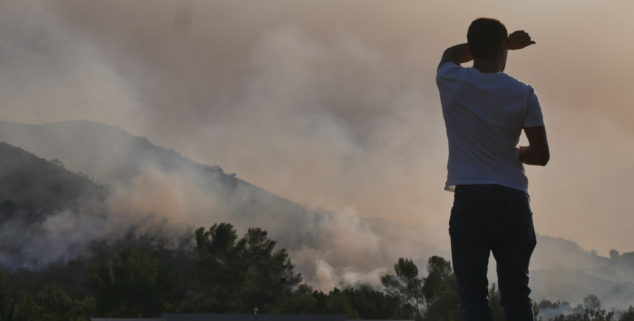News
Dry autumn winds bring fire threat — again
 A man watches the 2018 Woolsey fire in Los Angeles. (Photo: BrittanyNY, via Shutterstock)
A man watches the 2018 Woolsey fire in Los Angeles. (Photo: BrittanyNY, via Shutterstock)California’s relatively mellow start to the 2019 fire season may be the calm before the firestorm, according to the National Interagency Fire Center (NIFC).
California Department of Forestry and Fire Protection CAL FIRE agrees with the NIFC that when fall’s arid winds kick in — as they have in the last few days, prompting red flag alerts — California could experience another period of record wild fires. The fight against fires also is likely to be affected by a dispute with the Trump administration over money owed to local fire departments.
NIFC expects October and November to be most wildfire prone month. The culprit: Low humidity and strong wind events,
CAL FIRE reports that from Jan. 1 through Sept. 8 the state had 3,993 wildfires. The number is slightly below the five-year average of 4,346 and last year’s 4,378 fires over the same time period.
The good news is that most of this season’s fires have been small. Through Sept. 10, only 36,683 acres have burned, a total well below both the five-year average of 271,740 acres and 2018’s 626,083 acres, covering Jan. 1 to Aug. 18.
However, Predictive Services of the NIFC warns us not to get complacent. The NIFC’s September report — National Significant Wildland Fire Potential Outlook – states that “large fire potential is expected to remain above normal along much of the West Coast into October due rapidly drying live fuels and warmer, drier weather.”
NIFC expects October and November to be most wildfire prone month. The culprit: Low humidity and strong wind events, specifically southernly winds called Foehn Winds.
According to the NIFC, “a complete lack of monsoonal moisture kept sky conditions clear and drying conditions optimal in August,” a situation that has led to the curing of fuel – grasses, shrub, and trees. Additionally, the NIFC warns that “a blocking ridge may form over the northern Pacific, which may delay the onset of the ‘winter rainy season.’”
Local fire departments have been hamstrung by the Trump administration’s refusal to pay its bill for local efforts to fight 2018’s wildfires on federal land.
CAL FIRE’s deputy direct Michael Mohler confirms the NIFC’s prognosis, adding that this year’s above-average precipitation is “a double-edged sword.” More water means more fuel. This year’s late snow led to a late melt, which resulted in a “large crop of grasses,” which when dry serve as “a wick to fuel large wildfires.”
The heavy snow also caused damage to trees, resulting in fallen limbs – more “heavy fuel” to add to the “100 millions of dead trees from last year’s wildfires.”
The NIFC report backs Mohler, stating that “concerns this year are higher than average due to the presence of an abundant crop of fine fuels in the lower to middle elevations.” NIFC adds that “[t]he dead fuels are expected to be the primary driver of large fire activity the next few weeks as conditions are expected to be seasonally hot and dry.”
According to Mohler, Gov. Gavin Newsom’s Jan. 8 executive order has helped CAL FIRE work on lowering fire threats on state land by clearing debris and creating easy access to fire prone areas. CAL FIRE has also worked with private stakeholders on fire prevention and local fire departments on readiness.
Local fire departments, however, have been hamstrung by the Trump administration’s refusal to pay its bill for local efforts to fight 2018’s wildfires on federal land, withholding $9.3 million of the $72 million requested by the state.
Under 2015’s California Fire Assistance Agreement (CFAA) between the state and the federal government, the federal government is required to reimburse state and local fire agencies when they fight wildfires on federal land. California’s obligation is not small. Nearly 60% of California’s forests are owned by the federal government, much of it intersects with local, state and private land.
According to the Sacramento Bee, the U.S. Forest Service claims that local fire departments are using the FCAA to “overcharge” the federal government, an accusation disputed by California Office of Emergency Services (Cal OES) Fire Chief Brian Marshall. Marshall warns that the Trump administration withholding payment “would be cumbersome and would severely impact California’s ability to respond to fires.” The Bee also reports that local and state firefighters are dealing with the double-whammy of a longer fire season with historically big fires, and a federal government that is slower and slower in paying its bills.
An abundance of kindling, a massive amount of heavy fuel, high temperatures, arid winds, and a presidential administration refusing to pay what it owes to California firefighters: One spark and California faces major natural disasters compounded by fiscal shenanigans.
Prepare for a long hot fall.
Want to see more stories like this? Sign up for The Roundup, the free daily newsletter about California politics from the editors of Capitol Weekly. Stay up to date on the news you need to know.
Sign up below, then look for a confirmation email in your inbox.

Leave a Reply